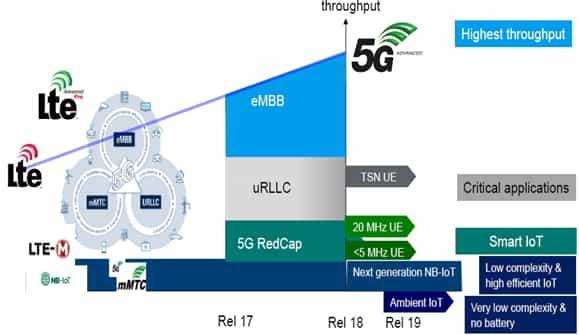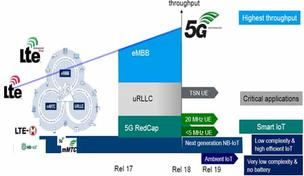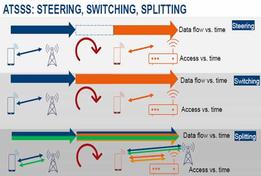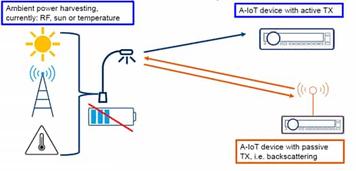Difference between 5G RedCap vs eRedCap
Advertisement
Introduction: RedCap (Reduced Capability) is a variant of the 5G New Radio (NR) standard introduced in 3GPP Release 17. It is sometimes called “NR-Light”. eRedCap (Enhanced/reduced Capability) is the next evolution of the RedCap concept, introduced in 3GPP Release 18. Both RedCap and eRedCap are part of 5G NR ecosystem designed for mid-tier IoT and connected devices.
5G RedCap : Key Features
- Reduced maximum bandwidth for the UE device compared to full 5G NR
- Reduced number of receive and transmit antennas
- Options for half duplex operation (in some bands) instead of full duplex
- Relaxed modulation order i.e. limiting to 64-QAM rather than 256-QAM in some cases
- Positioning of RedCap in the “broadband IoT” segment: more throughput and lower latency than LPWA, but lower device cost and power than full 5G eMBB.
5G eRedCap : Key Features
- A stricter peak data rate cap ( ~ 10 Mbps downlink and uplink)
- Maximum radio (RF) bandwidth remains similar to RedCap : 20 MHz, 5 MHz in some implementations
- Focus on very low cost/low complexity devices such as static sensors, asset trackers, ambient IoT tags, which do not require high mobility or high throughput.
- Use of same 5G SA (standalone) architecture as used by RedCap devices
 Image Courtesy : Rohde & Schwarz
Image Courtesy : Rohde & Schwarz
Key Differences
| Feature | RedCap (Standard) | eRedCap (Enhanced RedCap) | Remarks |
|---|---|---|---|
| 3GPP Release | Release 17 | Release 18 | eRedCap is the next evolution, defined in a later standard. |
| Primary Goal | Balance 5G performance with reduced cost for mid-tier IoT. | Further reduce cost and power for a wider range of simpler IoT devices. | eRedCap aggressively targets lower cost applications. |
| Peak Data Rate (Downlink) | Up to ~100 Mbps | Down to ~10 Mbps | A 10x reduction in peak speed, as many IoT devices don’t need that much bandwidth. |
| Minimum Device Bandwidth | 20 MHz (in FR1) | 5 MHz (in FR1) | Requires less spectrum, which simplifies the radio and lowers power consumption. |
| Antenna Configuration | 1 or 2 Transmit Antennas (1T); 2 Receive Antennas (2R) | 1 Transmit Antenna (1T); Optionally only 1 Receive Antenna (1R) | This is a critical difference. Moving from 2 receive antennas to 1 significantly reduces the cost, size, and complexity of the device’s radio front end. |
| Power Savings | Introduces new power saving features over standard 5G. | Introduces additional, more advanced power saving modes over Rel-17 RedCap. | eRedCap is designed to be even more frugal with battery life. |
| Typical Use Cases | Industrial Routers, high-quality CCTV, advanced wearables, vehicle telematics. | Simpler industrial sensors, smart grid devices, lower-cost security cameras, logistics trackers. | eRedCap expands the market to include devices where the cost and power budget of standard RedCap might still be too high. |
Summary: RedCap provides “5G Lite” for mid-tier IoT devices, eRedCap takes it one step further to “5G Ultra-Lite” for very low cost/power IoT devices. Both sit within the 5G NR family but with progressively more aggressive simplifications.
Advertisement
 RF
RF





